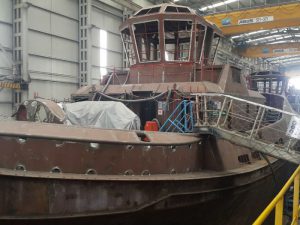
New versatile tug design from Robert Allan, Sanmar
NOVEMBER 11, 2017—Naval architect Robert Allan Ltd., have completed a new 25 m harbor tug design for Turkey’s Sanmar Shipyards that can be outfitted as either a tractor tug with aft working deck

NOVEMBER 11, 2017—Naval architect Robert Allan Ltd., have completed a new 25 m harbor tug design for Turkey’s Sanmar Shipyards that can be outfitted as either a tractor tug with aft working deck
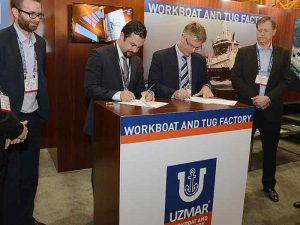
DECEMBER 7, 2016 — Robert Allan Ltd. has signed a new agreement with Turkey’s Uzmar Shipyard. In a ceremony held during the recent International Workboat Show, the companies signed documents marking the

APRIL 6, 2016—Marine Log is proud to announce that renowned naval architect Robert G. Allan, PE, will provide the keynote address for the Marine Log Tugs & Barges 2016 Conference & Expo,
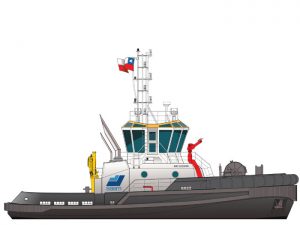
The first two boats, named Chincha and Tupac, are now under construction at the Wuxi Shipyard in China, for SAAM’s Peruvian affiliate Tramarsa, with others soon to follow.
In addition to the design, Robert Allan Ltd. also provided a complete structural steel parts package developed from the design drawings prepared for this project. Parts were defined and nested using ShipConstructor software, complete with part identification code, suitable as input to the shipbuilder’s NC burning code.
The 24.4 m long x 11.25 m beam RAmparts 2400-W Class tugboat is a twin Z-drive, diesel-powered tug, designed for maximum efficiency in the performance of ship-assist and terminal support operations. The hull form and layout have evolved through the extensive experience of the designers. Ship-handling is performed over the bow using a high-performance, split drum hawser winch.
The tugs will also provide firefighting capability and have up to date accommodations for a crew of six in two single and two double cabins.
The design complies with ABS requirements for the following notations: ✠A1, , ✠ AMS, Towing Vessel, UWILD, Fire-fighting Vessel Class 1 Particulars of the RAmparts 2400-W design are as follows: Length overall
NOVEMBER 20, 2012—Signet Maritime Corporation, Houston, TX, recently awarded a contract to Vancouver-based naval architectural firm of Robert Allan Ltd. for the design of an ASD 24/60 tractor tug. It is the
JUNE 4, 2012 — Robert Allan Ltd. of Vancouver, B.C., and Rotortug (KST) B.V. of Rotterdam have formed new strategic alliance for the future development of the Rotor Tug concept. Robert Allan
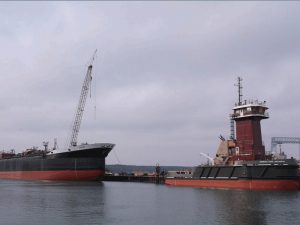
Nichols Brothers Boat Builders recently completed sea trials on the second of 10,000 hp oceangoing tugs for Kirby Offshore Marine, the coastal tug and barge arm of Kirby Corporation, Houston, TX. The 136 ft x 44 ft tug, Tina Pyne, will be connected to the 185,000 bbl ocean tank barge 185-02 built by Gunderson Marine, Portland, OR.
Kirby’s newbuild plan also includes two 155,000 bbl/6,000 hp Articulated Tug Barge (ATB) units under construction at Fincantieri Bay Shipbuilding in Sturgeon Bay, WI, as well as two 120 ft x 35 ft, 4,894 hp tugs being built by Nichols Brothers Boat Builders. Each tug will be powered by two Caterpillar 3516C engines, each rated at 2,447 hp at 1,600 rev/min, with Reintjes reduction gears turning two Nautican fixed-pitched propellers with fixed nozzles. The Reintjes gears were supplied by Karl Senner, LLC, Kenner, LA. The tugs will also have two C7.1 Caterpillar generators for electrical service. Selected deck machinery includes one TESD-34 Markey tow winch, one CEW-60 Markey electric capstan, and one Smith Berger Tow Pin.
Kirby Offshore Marine is the largest U.S. operator of coastal tank barges that provide regional distribution of refined petroleum products, black oil and crude oil. Kirby grew its coastal marine transportation business through the acquisition of K-Sea Transportation Partners L.P. back in 2011 in a transaction valued at about $604 million. At that time, Kirby acquired 58 tank barges (only 54 were double hull) with a capacity of 3.8 million barrels and 63 tugs.
Already the operator of the largest inland tank barges and towboats, Kirby Corporation will grow further with the purchase of Seacor Holdings Inc.’s inland tank barge fleet for about $88 million in cash.
Under the terms of the deal struck last month, Kirby will acquire 27 inland 30,000 bbl tank barges and 13 inland towboats, plus one 30,000 bbl tank barge and one towboat currently under construction. As part of the agreement, Kirby will transfer to Seacor the ownership of one Florida-based ship-docking tugboat.
Kirby Inland Marine currently has 898 active inland tank barges and 243 towboats, with a total carrying capacity of 17.9 million barrels. The primary cargoes transported by this fleet are chemicals, petrochemical feedstocks, gasoline additives, refined petroleum products, liquid fertilizer, black oil and pressurized products.
Kirby President and CEO David Grzebinski, says “Operating primarily in the refined products trade, these assets will be complementary to our existing fleet and will allow us to continue to enhance customer service.”
TRIPLE-SCREW BOATS FOR MID-RIVER
Over the years, Rodriguez Shipbuilding, Inc.’s triple-screw towboats have won a following operating in the shallow waters where the Mississippi River meets the Gulf of Mexico. These Lugger-type vessels are designed with a distinctive aft-cabin.
Mid-River Terminals of Osceola, AR, recently took delivery of a new design towboat from Rodriguez Shipbuilding, Coden, AL. With a conventional forward-house pusher configuration, the new 70 ft x 30 ft MV/ Dianna Lynn uses the same propulsion as the Lugger tugs. This is composed of three in-line six-cylinder Cummins QSK 19 engines, each delivering 660 hp. Each engine turns a 66-inch stainless steel propeller through ZF gears with 6:1 reduction ratio. The combination gives the 1,980 hp towboat an eight-foot operating draft.
Fitted with large windows, the wheelhouse has a full 360-degree view and is set atop two accommodation decks and a half deck that also serves for bridge electronics support. This gives the towboat a 31-foot high eye-level, with full tanks, for working high barges.
Steering and flanking rudders are controlled by wheelhouse levers with mechanical shafts through the houses and connected to the hydraulic actuator valves in the upper engine room.
A set of push knees and deck winches with cheek blocks facilitates barge work. A pair of 55 kW gensets meets the boat’s electrical requirements.
Zero discharge tanks, built integral to the hull, provide storage for treated sewage and all drains. A separate tank handles waste oil.
The M/V Dianna Lynn is the fourth boat in the Mid-River Terminal fleet, all of which are Cummins powered. Owner Rick Ellis said, “We wanted the three engines for redundancy so that even if we loose an engine we still have over 1,200 horsepower.”
The new boat will be primarily involved in fleeting and harbor work, “Rodriguez did a great job and it is a great handling boat,” Ellis added.
BOUCHARD, MORAN EXPANDING FLEETS
As we highlighted last month, Bouchard Transportation’s multi-million-dollar newbuild program is winding down. The Melville, NY, owner is completing the construction of two new 6,000 hp, 310 ft x 38 ft Intercon tugs at VT Halter Marine, Pascagoula, MS. The tugs Morton S. Bouchard Jr. and Fredrick E. Bouchard will be connected to the B. No. 210 and B. No. 220. The two tank barges were the first double hull tank barges built by Bouchard,. Both were built as wire barges, but following their conversion and stretch at Bollinger Shipyards, Inc., both will be Intercon, flat deck double hulls capable of carrying 110,000 bbl of oil.
Moran Towing, New Canaan, CT, expects to take delivery shortly of a 5,300 hp/110,000 bbl ATB unit from Fincantieri Bay Shipbuilding. The Sturgeon Bay, WI, has another 8,000hp/155,000 bbl ATB unit under construction for Plains All American Pipeline, with an option for a second unit, and signed a hotly contested order for another 8,000 hp/185,000 for another earlier last month. That contract includes an option for another.
The new barge will have a capacity of 185,000-barrels with dimensions of 578 feet by 78 feet. The tug will be an 8.000-HP unit equipped with Tier 4 engines—believed to be GE Marine—to meet the latest EPA emission standards.
When complete, the ATB will operate on the U.S. East Coast and Gulf of Mexico.
“We are pleased to have this opportunity,” said Francesco Valente, FMG President and CEO. “This new contract marks an additional expansion of our product portfolio, confirms our ability to win business with new customers in a very competitive market and further consolidates our presence and reach in the U.S. market.”
“This award increases our pipeline of new construction to 10 vessels and provides additional stability to our business,” said FBS Vice-President and General Manager, Todd Thayse. “We are grateful for the confidence that our customers continue to place in our reputation for quality and the strong shipbuilding skills of our workforce.”
Conrad Shipyards, Morgan City, LA, meanwhile, is building the 80,000 bbl ATB unit for John W. Stone, as well as two ATB tugs for Harley Marine Services, Seattle, WA. Conrad Orange Shipyard in Orange, TX, recently delivered the 35,000 bbl Double Skin 315 to Vane Brothers Company. That barge was towed to New York by the Elizabeth Anne, the first in a series of eight 4,200 hp tugs being built by St. Johns Ship Building, Palatka, FL.
Designed by Frank Basile, P.E. of Entech Designs, LLC, the Elizabeth Anne Class tugboat is a close cousin to Vane’s Basile-designed Patapsco Class tugboats, 15 of which were produced between 2004 and 2009. Measuring 100 feet long and 34 feet wide, with a hull depth of 15 feet, the model-bow Elizabeth Anne utilizes two Caterpillar 3516 Tier 3 engines, each generating 2,100 hhp at 1,600 rev/min. Two John Deere PowerTech 4045, 99 kW generators deliver service power to the boat, while a third John Deere 4045 teamed with an Allison transmission drives the chain-driven INTERCON DD200 towing winch.
 ROBERT ALLAN’S LATEST
ROBERT ALLAN’S LATEST
Over the years, world renowned naval architectural and marine engineering firm Robert Allan Ltd. Has successfully teamed with shipyards around the world to bring new innovative tug designs to the market. Its latest is the VectRA 3000 Class Tug, a high performance VSP Tractor tug designed by Robert Allan Ltd in close collaboration with Turkish ship builder Sanmar and Voith Turbo Propulsion. The tug is designed for maximum efficiency in the performance of towing, harbor ship-handling and escorting of large ships. Performance has been verified with extensive model tests at the commencement of the design cycle. The unique propulsion arrangement features high-speed diesel engines connected to the Voith units via reduction gearboxes with integral clutches. With a bollard pull of 70 tonnes, the VectRA 3000 form can generate escort steering forces in excess of 100 tonnes. Additionally, the design has fire-fighting and oil recovery capabilities and is fully MLC compliant.
The VectRA 3000 has been designed exclusively for Sanmar to offer as one of its highly successful stable of progressive tugboats for the world market.
The first vessel in the series, the M/T Ares, built for Italian tugowner Tripmare SpA, was successfully launched at Sanmar’s new Altinova advanced shipbuilding facility this past February.
The tug has an overall length of 30.25 m, beam of 13m, depth of 5.1m, and design draft of 6.1m.
The vessels are built and classed to the following ABS notation: ✠ A1 Towing Vessel, Escort Vessel, ✠ AMS, Unrestricted Service, UWILD, HAB (WB), ABCU Fire-Fighting Vessel Class 1 Oil Spill Recovery – Capability Class 2 (>60° C) (OSR – C2).
Rather uniquely for a VSP installation, the propulsion drivetrain comprises two Cat 3516C high-speed diesel engines, each rated 2,525 kW at 1,800 rev/min, and driving Voith 32R5EC/265-2 cycloidal propellers. The engines are connected to the Voith drives through a pair of Reintjes WAF 863 gearboxes and Vulkan composite shafts, rather than using the more traditional turbo coupling. This combination is smaller, lighter and less costly than the traditional medium speed drive system. The electrical plant consists of two identical diesel gensets, each with a rated output of 86 ekW.
Crew accommodations are all located on the main deck level for optimal crew comfort. There are 4 single crew cabins plus 1 double crew cabin, each with an en-suite bathroom. A comfortable lounge/mess area and galley facilities are also in the deckhouse, with galley stores and laundry room located below the main deck forward.
All towing, ship handling, and escort work is performed using a double drum escort winch and escort rated staple fitted on the aft deck. One drum can store 710 meters of steel wire line, while the other stores 150 meters of synthetic towline. For increased operational flexibility radial type tow hooks are installed on the main deck forward and aft.
As in a traditional tractor configuration, the stern is the working end of the tug, and as such features heavy-duty cylindrical fendering with a course of ‘W’ fenders below. Hollow ‘D’ fenders protect the sheer lines and tie neatly into the ‘W’ fenders at the bow.
The wheelhouse is designed for excellent 360-degree visibility and includes overhead windows. The split type console is biased aft to ensure unobstructed visibility of the working deck (including the winch, staple, bulwarks and fenders) during operations.
CARGILL’s PUSHBOATS FOR THE AMAZON
In Brazil, the construction of a fleet of Robert Allan Ltd.-designed pushboats and barges for Cargill Transportation is nearing completion. To be used for transporting grain products on the Amazon River system, the fleet includes two shallow-draft RApide 2800-Z2 class pushboats built at INACE in Fortaleza, Brazil and 20 hopper barges built at Rio Maguari in Belem, Brazil.
Each of the two new RApide 2800-Z2 Class pushboats are 28m x 10.5m, with a minimum operating draft of 2.2m and normal operating draft of 2.5m. The two sister vessels, the Cargill Cachara and Cargill Tucunare, are designed to push barge convoys on the Amazon River system.
During the early phases of design, extensive CFD simulations were undertaken to optimize the pushboat’s hull shape to minimize total convoy resistance.
This work was completed in conjunction with extensive logistics modeling of the transportation system to optimize the selection of vessels for the desired route and to analyze operational drafts and cargo throughput at various river levels.
The pushboats were designed to ABS and Brazilian NORMAM-02 requirements and are outfitted to the highest standards.
The wheelhouse is designed for maximum all-round visibility with a split forward control station providing maximum visibility to the foredeck working area of the tug as well as to the convoy of barges ahead. Accommodation for up to 13 people is provided onboard and a large galley and mess is provided on the main deck.
The deckhouse extends aft over the main propulsion components, which comprise a pair of Caterpillar 3512B diesel engines, driving Schottel SRP 550 Z-drive units. The drives are fitted in tunnels designed to optimize flow while reducing draft. Two identical Caterpillar diesel gensets are provided in the vessel’s auxiliary machinery space located below the main deck.
The corresponding 61m x 15m box and rake barges were designed by Robert Allan Ltd. to ABS River Rule requirements. Additional extensive FEA analysis of the structure was performed in order to optimize the design for minimum steel weight while ensuring long service life during river operations. Sliding aluminum hatch covers have been supplied to ensure the cargo stays dry at all times.
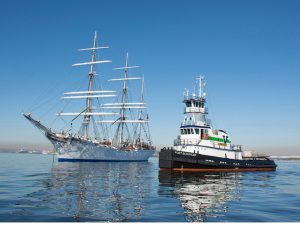
If you were at a seaport along the U.S. Eastern Seaboard, more than likely you would be able to spot the distinctive blue “V” logo of the Vane Brothers Company on at least one tug in the harbor. The privately held marine transportation company has been serving the U.S. East Coast for more than 100 years, now handling chemical and petroleum products on its double-skin tank barges in seven ports from New York to Jacksonville, FL.
Under the steady guidance of C. Duff Hughes, the third generation of the Hughes family at the helm of the company, Vane Brothers, headquartered in Baltimore, MD, has been aggressively growing its fleet of 120 tugs and barges. Since 2008, Vane Brothers has been adding a series of 3,000-hp, Sassafras Class Articulated Tug Barge (ATB) tugs. Just last month, Vane Bros. ordered the 15th, 16th, and 17th of the class, all of which have been ordered from and built by Chesapeake Shipbuilding in Salisbury on the Eastern Shore of Maryland.
 The latest in the series delivered by Chesapeake Shipbuilding is the Fort Schuyler, the eleventh in the class. Its sister tug, the Kings Point, was delivered in April this year.
The latest in the series delivered by Chesapeake Shipbuilding is the Fort Schuyler, the eleventh in the class. Its sister tug, the Kings Point, was delivered in April this year.
The tugs have been very popular with the company’s crews. Vane Brothers Senior Port Captain Jim Demske, says, “The crews on these tugs particularly like the high quality of the tugs’ construction and layout. The ergonomic arrangement of the pilothouses and engine rooms contribute comfort and safety. The power from the Caterpillar engines and the performance from the Twin Disc reduction gears all contribute to the great handling of these tugs, which is especially appealing to the operators. The new Simrad Solid State Halo radars and touch-screen electronics are some of the finest in the industry and also make life on these tugs better.”
Measuring 94 feet long and 32 feet wide with a hull depth of 13 feet, the Fort Schuyler is similar in most respects to the previous 10 tugs built for Vane by the shipyard.
The vessel is equipped with twin Caterpillar 3512 Tier 3 main engines producing a combined 3,000 horsepower, and operates with a single-drum hydraulic towing winch from JonRie Intertech, Manahawkin, NJ.
“Soft-core” panels and heavy, fire-rated doors are used throughout the boats, offering the crew a safer and quieter living environment.
“Vane Brothers and Chesapeake Shipbuilding continue to have a very strong relationship,” says Demske. “The next tug to be launched in coming weeks will be the Fort McHenry, followed by the Fishing Creek.” Demske says the names of the other tugs have yet to be announced.
The Fort Schuyler, like the Kings Point, has joined Vane Brothers’ fleet based in New York. The two vessels are named for the campuses of SUNY Maritime College in Fort Schuyler, NY, and the U.S. Merchant Marine Academy in Kings Point, NY.
In addition to the 3,000-hp tugs coming from Chesapeake Shipbuilding, there are two 4,200-hp tugs under construction at St. Johns Ship Building in Palatka, FL, for delivery in 2016, with two more under contract.
VANE ADDS NEW BARGES, TOO
According to Vane Brothers, three 35,000-barrel barges and four 55,000-barrel barges (including the 509A asphalt barge) have been delivered in the last 10 months, with another 55,000-barrel barge expected before the end of the year. These have come primarily from Conrad Shipyards in Orange, TX, and Amelia, LA, as well as Jeffboat in Jeffersonville, IN.
New and current mariners at Vane have a variety of training opportunities available to them, both formal and informal. According to Vane Brothers spokesman Blaise Willig, the company has supported many vessel-based employees this year as they receive instruction to help them be more effective at their current jobs and contribute to their future advancement. Vane is a Partner Company in the Workboat Academy’s Workboat Program. And, as a result of Person in Charge (PIC) Barge training this year at the Maritime Institute of Technology and Graduate Studies (MITAGS) in Linthicum Heights, MD, former Vane Deckhands have become highly qualified Tankermen now assigned to Vane barges. Vane’s training efforts and commitment to promoting from within help to ensure that its vessels are manned with professionals who meet and surpass the highest standards in the industry.
NEW ATB TUG LAUNCHED FOR BOUCHARD
Early last month, the Moss Point Marine shipyard of VT Halter Marine, Inc., launched the M/V Morton S. Bouchard a 6,000hp, twin-screw Articulated Tug Barge (ATB) tug for Bouchard Transportation, Inc., Melville, NY.
The ATB tug is one of two sister vessels being built under a two-vessel contract signed in August 2014. Morton S. Bouchard and sister vessel Frederick E. Bouchard each measure 130 feet by 38 feet by 22 feet and is classed by ABS as +A1 Ocean Towing, Dual Mode ATB, USCG Subchapter C. On completion, both tugs will be equipped with an Intercon Coupler System. Deliveries are expected in January and May 2016, respectively. The vessels will enter into Bouchard Transportation’s fleet service in New York, NY.
This most recent launch follows the September launch from the Moss Point shipyard of another ATB tug for Bouchard, the 10,000 hp M/V Donna J. Bouchard.
Also equipped with an Intercon Coupler, Donna J. Bouchard, is classed by ABS as +A1 Towing Vessel, Dual Mode ATB, USCG Subchapter M. She will be paired with barge B.No.272, which is currently under construction at VT Halter Marine’s Pascagoula, MS, shipyard to comprise the second ATB unit built for Bouchard Transportation as part of its major expansion program.
“Bouchard Transportation Co. Inc. is happy to announce yet another successful launching of a state of the art ATB tug built by VT Halter Marine. The launching of the M/V Morton S. Bouchard Jr. is a special event within the Bouchard Family, for the vessel is named after the father of President/CEO, Morton S. Bouchard III, who wanted his father’s name to always remain on the waterfront for which he dedicated his entire fife to. The original tug, Morton S. Bouchard Jr., which was also built by Halter, was earlier renamed as The Bouchard Boys and continues to operate with Bouchard Fleet,” says Morton S. Bouchard III President and CEO, Bouchard Transportation.
“The successful launching of both vessels, the M/V Morton S. Bouchard Jr. today and the M/V Donna J. Bouchard in September is an indication of the commitment to the continued relationship with Bouchard Transportation,” says Jack Prendergast, CEO, VT Halter Marine.
 NEW ATB TUG FOR MORAN
NEW ATB TUG FOR MORAN
Moran Towing has newbuild programs underway at Washburn & Doughty shipyard in East Boothbay, ME, and Fincantieri’s Bay Shipbuilding in Stugeon Bay, WI. Its newest ATB tug, Leigh Ann Moran, recently completed her sea trials in Sturgeon Bay. The 121 ft x 36 ft tug was christened in late September by her namesake, Leigh Ann Engibous, wife of long-time Chevron employee Bill Engibous.
Also under contract at Bay Shipbuilding are the 121 ft x 36 ft ATB tug Barbara Carol Ann Moran and a 110,000 bbl double-skin tank barge, which are due for delivery in the second quarter of next year.
Meanwhile, Washburn & Doughty have contracts for six 6,000 hp Z-drive harbor tugs for the New Canaan, CT-based tug company.
MCALLISTER PUBLISHES 150th ANNIVERSARY BOOK
Last year, McAllister Towing & Transportation Co., New York, NY, celebrated its 150th anniversary of providing marine transportation, towing and harbor services. The beautifully bound hard cover book recounts the history of the five generations of the McAllister family and the tugboat business. The company was founded by James McAllister, who arrived in New York City following a shipwreck and soon bought his first sail lighter in 1864. From those humble beginnings, the distinctive red and white striped funnels of McAllister tugs can be seen from Portland, ME, to San Juan, PR.
McAllister currently has one ABS-classed 5,000-hp Z-drive reverse tractor tug on order at Eastern Shipbuilding Group, Panama City, FL. The word on the street is that the company is in serious discussions with another shipyard regarding the construction of at least two other harbor tugs.
Eastern Shipbuilding also recently launched the H. Douglas M, the first in a series of four 5,150 hp escort tugs for Bay-Houston Towing. The 80 ft x 38 ft tug is based on a Z-Tech 2400 Class design by Robert Allan Ltd. Delivery of the escort tug is scheduled for early 2016.
The same design is being built by Eastern Shipbuilding for a series of four tugs for Suderman & Young. G&H Towing is the owners’ onsite representative and agent during the engineering, construction, and delivery for both Bay-Houston and Suderman & Young Towing.
WIND FARM VESSEL TAKES SHAPE
In Warren, RI, the first U.S.-flag wind farm vessel is taking shape at Blount Boats, Inc. Blount Boats President Marcia Blount says the 21-meter aluminum catamaran will be ready for delivery in April 2016.
Rhode Island Fast Ferry will operate the boat for Block Island Wind Farm in Rhode Island. The five turbine wind farm, the first commercial wind farm in the U.S., is expected to be up and running by the fourth quarter of next year.
The catamaran is a Crew Transfer Vessel (CTV) based on a design licensed from South Boats (IOW), Isle of Wight, the U.K., one of the leading designers and manufacturers of wind farm vessels in Europe. South Boats IOW has designed and built some 85 CTV’s for the European offshore wind sector.
Blount Boats is eyeing the progress of offshore wind energy closely, says Marcia Blount.
Blount Boats also is building a passenger vessel for Chicago’s Shoreline Sightseeing. Shoreline Sightseeing provides guided architecture tours on the Chicago River, as well as classic tours on Lake Michigan and “Brew Cruises” and wine-tasting cruises.
NEW BOATS FOR CIRCLE LINE
About a 20-minute ride from Warren, RI, is the shipyard of Gladding-Hearn Shipbuilding, a Duclos Corporation in Somerset, MA. Known for their construction of aluminum, multi-hull vessels based on IncatCrowther designs, the Massachusetts shipbuilder is actually building three all-steel 600-passenger vessels for Circle Line Sightseeing Yachts, Inc., New York, NY. The 165 ft x 34 ft were designed by DeJong & Lebet, Jacksonville, FL. Those boats are due for delivery in the spring.
It’s also building a 493-passenger ferry for Hy-Line Cruises due for delivery in 2016.
One of the latest deliveries from Gladding-Hearn is the Manatee, a 28-knot Chesapeake Class launch and the first in a new generation of the popular, mid-size pilot boats for the Tampa Bay Pilots Association.
The boat continues a successful partnership between Gladding-Hearn and C. Raymond Hunt Associates, Inc., New Bedford, MA.
The Somerset, MA, shipyard introduced the Chesapeake Class pilot boat in 2003. Since then, 15 have been delivered to pilot associations throughout the U.S.
The latest improvements incorporate the performance benefits of Volvo Penta’s IPS2 inboard propulsion system.
“The IPS2 system was created to improve the performance and the arrangement of planning hulls like our pilot boats,” says Peter Duclos, the shipyard’s president. “This new generation of Chesapeake launches, named Chesapeake Class MKII, is equipped with the IPS2 pods, which provide what pilots have been asking for: higher speeds, lower fuel consumption, and more comfort.”
With a deep-V hull designed by C. Raymond Hunt & Associates, the all-aluminum pilot boat measures 52.7 ft overall, with a 16.8-ft beam and a 4.5-ft draft.
It is powered by two Volvo Penta D11, six cylinder, EPA Tier 3 diesel engines, each producing 503 bhp at 2,250 rev/min. Each engine is connected to a Volvo Penta IPS propulsion pod, which is fitted with dual forward-facing, counter-rotating propellers and integrated exhaust system, and Volvo Penta’s integrated EPS electronic steering and control system.
The EPS control system and three-axis joystick increases the boat’s overall maneuverability alongside a ship and when docking, says Duclos.
The financial incentive for the Tampa Bay pilots to optimize fuel economy, vessel handling and comfort led the shipyard to install a Humphree Interceptor automatic trim- optimization system.
“The combination of the Volvo Penta IPS system and the Humphree interceptors gives the pilots higher speeds and improved comfort, while burning 25 percent less fuel than similar Chesapeake Class launches,” says Duclos.
Key design changes to the Chesapeake Class MKII include positioning the wheelhouse aft of amidships to improve comfort and provide for a larger foredeck.
With the pods close-coupled to the engines, the engine room is located well aft of the wheelhouse with easy access to machinery through a deck hatch.
This new generation of pilot boats is also designed to accept a gyro-stabilization system, designed to reduce vessel roll.
MIX OF REPAIR AT DETYENS
This past year, there has been a good mix of commercial and government repair at Detyens Shipyards, Inc., Charleston, SC, according to the company’s Bradley Kerr. “We have recently completed work on two German owned-container vessels, a pair of casino vessels and have the usual tugs and barge units, dredge vessel and other similar harbor barges are rolling through. We also have recently won MSC contracts on the Button and Spearhead as well as the Atlantis from Woods Hole.”
The largest commercial ship repair yard on the U.S. East Coast, Detyens also recently finished repairs on the USCG Elm and will begin work on the NOAA vessel Gordon Gunter soon. The Dredge Wheeler is also in the shipyard.
This past spring and summer, Detyens dry docked the ferries 28,460 gt M/V Highlanders and 18,523 gt M/V Leif Ericson for Marine Atlantic, Inc., St John’s, Newfoundland, Canada.
FERRY REPOWER AT CADDELL
Over the next five years, the Delaware River and Bay Authority, owner and operator of the Cape May-Lewes Ferry, plans to repower its entire fleet with cleaner burning, more fuel efficient Tier 3-compliant diesel engines.
The first of those ferries, the Delaware, arrived at Caddell Dry Dock on Staten Island, NY, on November 2 to begin the four- to five-month repower project in conjunction with its regulatory required five-year drydocking.
According to James Gillespie, Chief Port Engineer for the Cape May Lewes ferry, the Delaware is expected to return to service in April of 2016. The dry-docking is expected to cost $3.5 million.
“We’re excited to begin our vessel repowering program,” says Heath Gehrke, Director of Operations for the Cape May-Lewes Ferry. “These new engines not only burn less fuel and are more efficient, but emissions are reduced by nearly 40 percent. By undertaking this effort, we can significantly extend the useful life of our fleet and provide a cleaner environment in the communities we serve.”
Gehrke also notes that the ferry expects to save about $130,000 per year in maintenance costs associated with old engines and that the new clean diesel engines have the capability to be converted to operate on natural gas in the future.
The existing Fairbanks Morse engines are overhauled and rebuilt every 10,000 hours of usage compared to every 30,000 hours for the new EMD (Electro-Motive Division) engines. The engines were purchased from Marine Systems Inc. at a cost of $1.8 million.
While at the shipyard, the vessel will have other modifications and improvements completed, including the installation of a new gray water recovery system, new stainless steel railings and new propeller shaft seal system; installation of a new keel cooler system for main engine and generator cooling; and the bow thruster system will be overhauled.
To further assist the University of Delaware’s water research efforts on the Delaware Bay, the SeaKeeper seawater monitoring system, which collects water quality data while a vessel transits the Delaware Bay, will be installed on the MV Delaware.
During a ceremony held at the Lewes Ferry terminal in December 2014, U.S. EPA Regional Administrator Shawn M. Garvin announced the award of a Diesel Emission Reduction Act (DERA) grant of $970,000 to help facilitate the project. The Delaware River and Bay Authority (DRBA) sought the grant funding through the National Clean Diesel Assistance Program, which focuses on reducing emissions at ports under the Diesel Emission Reduction Act (DERA).
The M/V Delaware is currently equipped with two Fairbanks Morse 38D8-1/8 propulsion engines with a power rating of 2,060 horsepower each. More than 40 years old, these workhorse engines are approaching 100,000 operating hours or the equivalent of 1.5 million miles. In addition, because the engines are no longer built, spare parts are both difficult to find and expensive.
Within the next five years, the Authority plans to repower the other vessels in the Cape May – Lewes Ferry fleet: the MV New Jersey and MV Cape Henlopen.
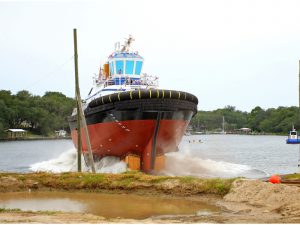
Designed by Robert Allan Ltd., Vancouver, BC, Canada, the Triton is the result of the successful operation of the first two Z-Tech 2400 tugs, Chloe K and Zeus, which were built for G & H Towing. The Triton also incorporates the lessons learned during 5 years of operation of eight previously built larger Z-Tech 7500 class tugs, starting with Thor in 2007. Those tugs are all operate by G&H Towing. The Triton is expected to be delivered before the end of 2015.
Joseph D’Isernia, Eastern Shipbuilding’s President, hosted the launching ceremony. Lisa Nigro, wife of Mike Nigro, VP of G & H Towing, christened the vessel, breaking the traditional bottle of champagne on the tug’s hull.
The Triton has an overall length of 80 feet, beam of 38 feet 3 in., depth of 15 feet 9 in., and operating draft of 16 feet 10 in. The propulsion power for the tug is supplied by two Caterpillar 3516C Tier 3-compliant diesel engines, each rated at 2,575 hp at 1,600 rev/min. The Triton has two Schottel SRP 1215 fixed pitch Z-drives for propulsion, with an expected bollard pull of 66 tonnes. Other equipment includes a Markey Machinery Fairleader 50-hp electric hawser winch. The tug is classed ABS +A1, Towing Vessel, AMS and Escort Service ABS Loadline (SoC), Statement of Compliance.
G&H Towing Company is the owners’ onsite representative and agent during the engineering, construction and delivery of the eight tugs for both Suderman & Young and Bay Houston. G&H Towing Company will operate the vessels after delivery.
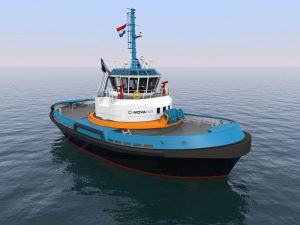
Additionally, Multraship has also agreed a deal with Damen for a new state-of-the-art ASD 3212 tug as part of its planned fleet expansion
Construction of the CRTs will begin immediately. The hulls of the vessels will be built by German shipbuilder Theodor Buschmann GmbH in Hamburg, with final outfitting carried out by Damen Maaskant Shipyards in Stellendam, the Netherlands. Delivery of the Bureau Veritas-classed vessels is scheduled for first-quarter 2017.
The Carrousel towing system consists of a towing point on a straightforward steel ring, freely rotating around the superstructure of the tug. According to Novatug, a towing load simply cannot capsize a Carrousel tug and the tug’s own hull profile can safely be used for generating braking and/or steering forces, based on the lateral resistance of the hull through the water and given the kinetic energy present in the moving tow and/or the current.
In the CRT, this towing system is combined with the advantages of the RAVE Tug (Robert Allan Ltd. – Voith Escort) jointly developed by naval architectural consultancy Robert Allan Ltd. and Voith Turbo Marine. The unique characteristic of the concept is the longitudinal alignment of two Voith drives, delivering very precise and improved force generation characteristics.
The CRTs have an overall length of 32 m, and a bollard pull of minimum 70 tonnes. Propulsion is via two Voith thruster units and two ABC main engines of 2,650 kW operating at 1,000 rpm. Free running speed is over 14 knots at 5,300 kW.
The CRT’s combination of low operational costs, speed of action and enhanced control over the tow can provide major advantages over conventional tugs, for example by widening or even removing tidal and/or weather windows for certain ports.
Novatug will offer the Carrousel Rave tugs on the basis of long-term bareboat charters, basically a financial or operational lease construction, an arrangement proven in other capital-intensive industries such as aviation. Its customer for the first two units is its parent, Multraship.
Leendert Muller, managing director of Multraship, says, “Safety is always our overriding objective, and that it is why we have opted wholeheartedly to produce the Novatug CRT. This new tug design, for the first time, eliminates what has always been the most significant threat to safety in towing – the risk of capsizing under a tow load. The benefits in terms of efficiency and flexibility, meanwhile, are also enormous.”

Carrousel Rave Tug
ASD TUG
The new state-of-the-art ASD 3212 tug acquired by Multraship — the Dutch-flag, LR-registered Multratug 31 — was built at Damen Song Cam, Vietnam. A sister vessel to Multratugs 19, 29 and 30, it will operate mainly in the Western Scheldt area. It has a maximum bollard pull of 83.2 tonnes and a maximum speed of 15 knots.
The 453 gt vessel is powered by two Caterpillar 3516C engines and has two Rolls Royce Azimuth thrusters and a 2,800 mm-diameter controllable pitch propeller.The vessel’s deck layout features a hydraulically driven escort double drum winch forward and single drum aft, and a 25 mt deck crane. There are two one-man cabins, four two-man cabins, a mess room and galley.